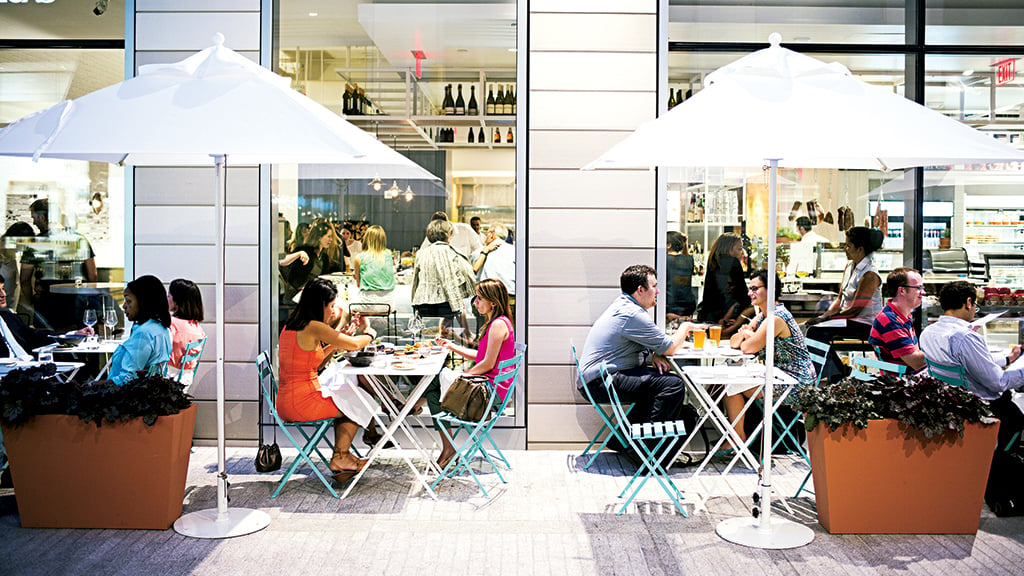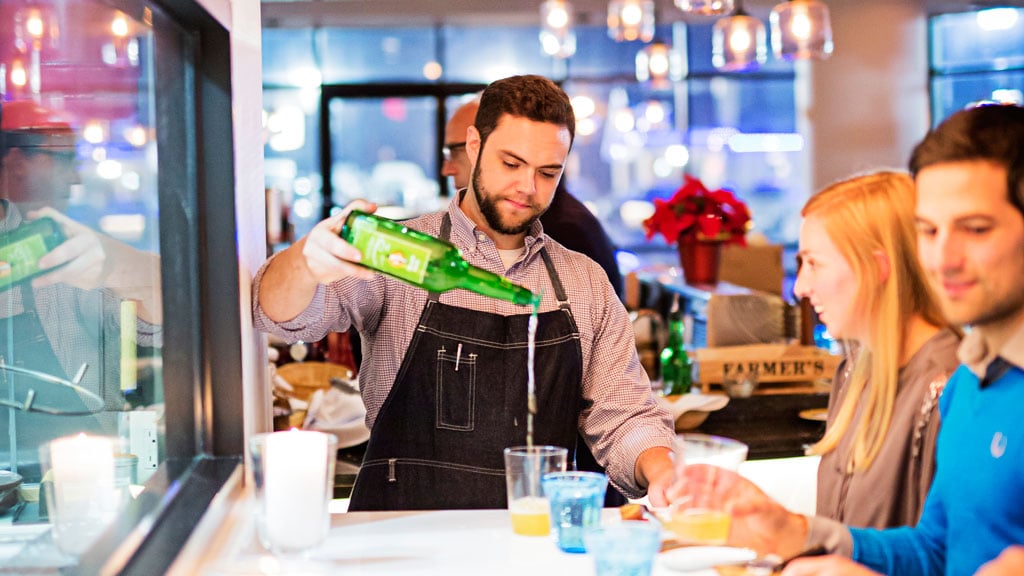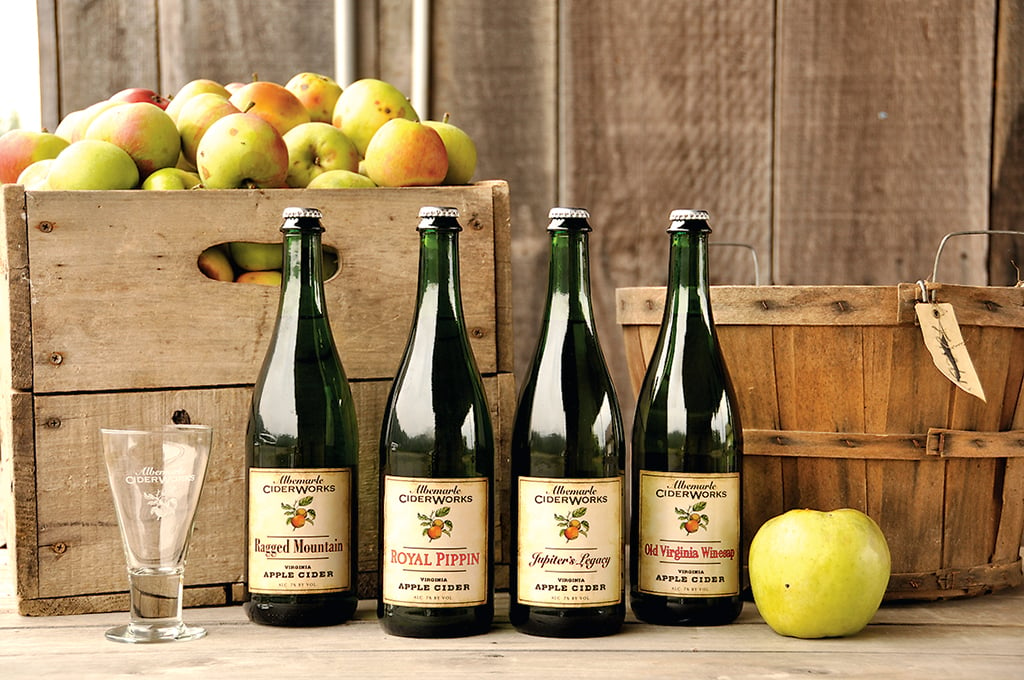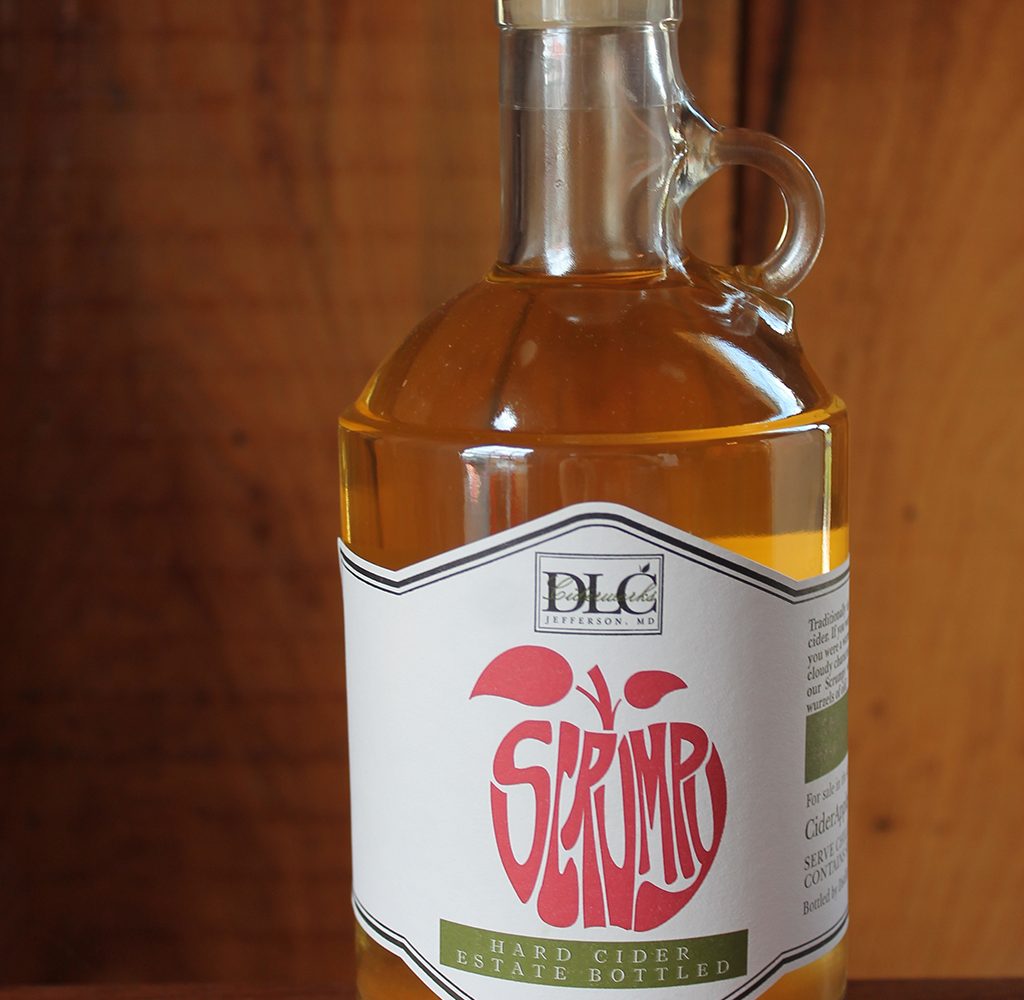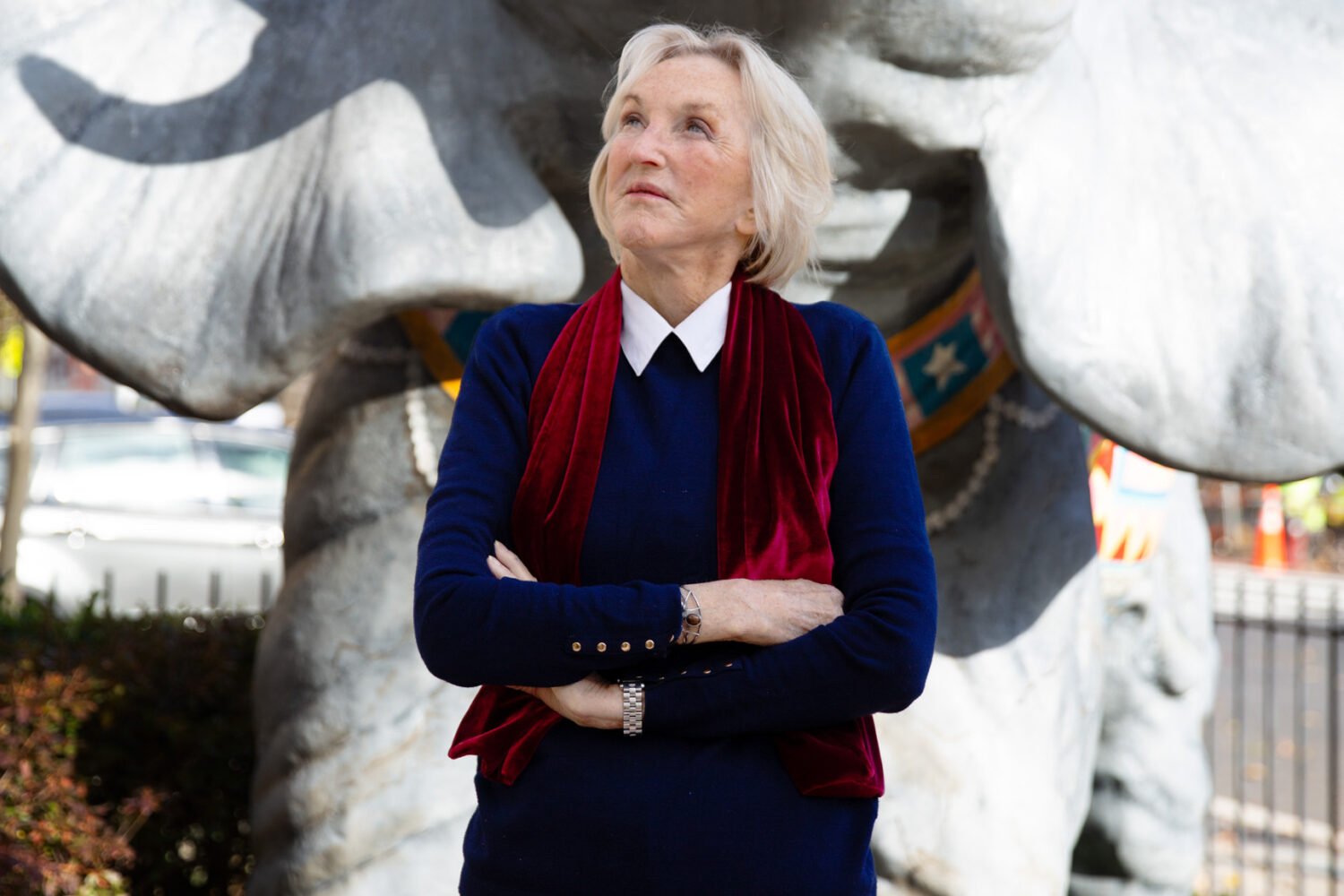Washington's bistros are the culinary heritage of the Kennedy years. No other first couple exerted as much influence on the capital's taste in the arts, fashion, and dining as Jack and Jackie Kennedy. When it came to cuisine, their tastes were French. During the 1960 presidential race, Kennedy called on Fred Decre, the chef of La Caravelle in Manhattan, to cater such delicacies as chicken breast with Champagne sauce for in-flight meals on his campaign plane.
After his election, Kennedy let it be known that he was giving as much thought to a new White House chef as he was to his Cabinet. When René Verdon was hired, newspapers treated his arrival as news. In 1960 Washington was mostly a serious steak-and-whiskey town, but with Verdon in the White House kitchen, the capital began to follow the President's dining tastes.
Most of the French restaurants from the Kennedy years specialized in haute cuisine and formal service. The choice tables were at Rive Gauche, La Salle de Bois, and Sans Souci. One of the rare cuisine bourgeoise restaurants of the era was Le Bistro, near 18th and M streets, Northwest, which became fashionable after Jacqueline Kennedy stopped by for lunch with friends.
In the early 1970s, moderately priced French restaurants with reliable cooking and more relaxed service began to appear. L'Escargot in Cleveland Park was one of the first. It became a magnet for the Francophiles of Georgetown, who lacked a bistro to call their own.
They did not have to wait long: In 1974 a loud, smoky place called Cafe de Paris was an overnight success. It was followed by Bistro Francais–which opened half a block from Rive Gauche in 1975–Au Pied de Cochon, La Ruche, and La Chaumiére. Georgetown, where the Kennedys had lived during his years as a senator, could claim more bistros than any other neighborhood in the city. Two other notable openings were Le Gaulois in Foggy Bottom and La Brasserie on Capitol Hill.
The 1980s were not vintage years for bistros, the only arrivals of note being the Alexandria branch of Le Gaulois and a pleasant little storefront called Tout Va Bien in Georgetown.
Starting with Lavandou, which brought authentic Provençal cooking to Cleveland Park in 1990, the past 14 years have seen the arrival of almost as many bistros as opened in the 1970s and '80s. Instead of being clustered in DC's nightlife districts, most flourish in neighborhoods: Bistrot Lepic in upper Georgetown, Bistrot du Coin in Dupont Circle, Petits Plats in Woodley Park, and Montmartre on Capitol Hill. Brasserie Les Halles and Bistro d'Oc are both in DC's theater district.
Maryland and Virginia also have benefited from the wave of bistro openings: In terms of quality, Mannequin Pis in Olney and La Côte d'Or Cafe in Arlington would be assets to any neighborhood.
While the haute cuisine palaces of the '60s, '70s, and '80s are long gone–as are such nouvelle cuisine laboratories as Le Pavillon, Jean-Louis, and Lespinasse–the city's bistros are thriving. Most are neighborhood restaurants whose regular clientele lives within walking distance of their dining rooms.
But bistros are more than neighborhood places. The best offer a consistent cuisine that represents the highest ratio of quality-to-price to be found in any category of non-Asian restaurants, and they attract diners from outside their neighborhoods.
The enduring appeal of French bistros is that they cook the comforting dishes that their patrons lack either the skill or the patience to cook at home. The time required to make the stock for a proper onion soup–to say nothing of caramelizing the onions without burning them–is daunting to most cooks. And while most bistro patrons can grill a steak, how many are willing to master the art of making perfect French fries to accompany it?
This survey of bistros emphasizes their ability to provide the classic French dishes–onion soup, pâté de campagne, pike quenelles, steak frites, duck confit, cassoulet, choucroute garni, and Dover sole à la meunière, plus the stews of veal, beef, chicken, lamb, and rabbit that go well in cooler weather.
Bistro desserts traditionally are uncomplicated sweets: fruit tarts, chocolate mousse, caramel custard, and pears or peaches poached in red wine. They are good, but after a first course and a main course, there may be little room left for anything more than oeufs à la neige ("snow eggs"), a classic bistro confection comprising large ovals of meringue poached in sweetened, vanilla-flavored milk and served in a pool of crème Anglaise. As light as flavored air, it is an ideal choice after a robust meal.
Although the menu prices at many of the established bistros seem little higher than they were a decade ago, plenty of bottles on their wine lists are in the $40-to-$60 range. The best buys–many priced between $26 and $36–are the unpretentious country wines of France. They are usually carefully selected by the owner, so you need not worry that an unfamiliar appellation, such as a Fitou or a Saint-Chinian, will be less than a delightful discovery.
The steadiest dining performers on this list are the oldest places: Bistro Francais, La Chaumiére, and Lavandou. With the exception of Montmartre, some of the newer bistros, all of which earned early critical praise, are going through a bumpy adolescence in which even some of their signature dishes have become inconsistent.
Prices at all the bistros reviewed are moderate. At dinner, most main courses are under $20, first courses under $9. Dinner for two, with two courses, a bottle of French country wine, tax, and tip, will usually cost $80 to $100. If you begin with foie gras and a glass of Muscat de Beaumes-de-Venise, followed by Dover sole and a bottle of Meursault, you'll pay more for the luxuries.
Lavandou (3321 Connecticut Ave., NW; 202-966-3003). Françis Devilliers, a Parisian in love with the cuisine of Provence, opened Lavandou in 1990. Its airy dining room, whose front windows are open during nice weather, gives no hint of the dim little bistro that Lavandou was during its early years.
Lavandou was the only bistro to offer a menu devoted to a single regional French cuisine. Devilliers never let refined Parisian sensibilities or a fear that the genuine article would not please American tastes stop him from serving authentic Provençal cuisine in all its garlicky glory.
All of the ingredients that fuel the exuberance of Provençal cooking–garlic, anchovies, picholine and niçoise olives, olive oil, capers, cayenne pepper, dried orange peel, and a multiplicity of herbs–were used with abandon. In the past when local French chefs made rouille–the thick sauce spread on slices of grilled bread that are floated on fish soup or bouillabaisse–the result resembled a pink mayonnaise with the barest hints of garlic and cayenne pepper. The rouille that accompanies the bouillabaisse that is a Wednesday-night special at Lavandou is reddish-brown like rust–which is what its name means in French. It is a mayonnaise-like texture of garlic, cayenne, and olive oil, bound with egg yolks, that causes euphoria.
Like a red Bandol from Domaine Tempier, Lavandou has aged beautifully. Some of its plates are presented a little more attractively than in earlier years, but most still astound with their vigorous flavors. The cooking remains consistent: Over the course of five meals, the only technically flawed dish was the carbonado–a lamb stew with beans, carrots, celery, and artichokes whose cubes of meat were dried out because they had been cooked at too high a temperature.
Lavandou's pâté de campagne was the best of the nine sampled for this survey. Relatively light for this characteristically robust charcuterie, its assertive seasoning made it a very good first course.
A signature first course since Lavandou's renovation has been the pissaladière, a miniature version of the savory tarts sold in pizza restaurants in Nice. Start a meal here with the traditionally topped pissaladière–a generous tangle of wilted onions, black olives, and anchovies–and you'll understand why anyone who has visited Nice remembers his first taste of the dish.
Another delicious first course is a plate of roasted red peppers wrapped around goat cheese and sauced with ribbons of anchoiade, a vibrant purée of anchovies and garlic. And if it's on the list of seasonal specials, don't hesitate to start with a splendid salad of fresh fava beans, sheep's-milk cheese, diced tomatoes, hazelnuts, and a generous sprinkling of minced garlic fried to a crisp golden-brown. It is a bowlful of the tastes of Provence.
Along with a frequently changing list of seasonal specials, there are two main courses on Lavandou's set menu that merit a visit. The first is a plate of sautéed monkfish presented atop a mound of spinach studded with mussels and finely minced garlic and surrounded by a creamy, electric-yellow saffron-rich sauce. The combination of mussels, spinach, and garlic is traditional, the pairing of monkfish and saffron sauce is contemporary, and the whole captures the simplicity and the incisiveness of flavors at the heart of Provençal cooking.
Among the excellent stews offered at local bistros is Lavandou's Daube Provençale. With its cubes of beef marinated overnight in red wine with aromatic vegetables, this a classic daube whose richly winey sauce is almost as dark as the covered Staub casserole in which it is rewarmed and served. When the diner lifts the brass-knobbed lid, he finds his stew topped with a small gratin of macaroni. Comfort food doesn't get better than this.
Françis Devilliers has assembled a wine list that represents the well-known wines of Provence and offers some delicious surprises from lesser-known vineyards. From the southern Rhône, Marquis de Sade Côtes du Ventoux is a rich, soft, fruity red that is a good match for the bouillabaisse and monkfish and ideal with the daube. And yes, the vineyard is owned by a descendant of the naughty nobleman, but at $28, the wine is all pleasure and no pain.
Bistrot du Coin (1738 Connecticut Ave., NW; 202-234-6969). A hybrid of three types of moderately priced Parisian dining establishments, Bistrot du Coin averages more than 400 customers a day by accommodating appetites large and small. It is a bistro by virtue of its name and a menu that includes a selection of classic stews; a brasserie in its full menu from opening until closing; and a cafe in that it serves tartines, the open-faced sandwiches served at Parisian cafes as accompaniments to a glass or two of wine.
In terms of atmosphere, it is two different restaurants: At lunch, when it is rarely more than half-full on weekdays, it is a placid refuge where one can linger over an aperitif of Ricard or Suze before enjoying a leisurely lunch. From the peak of the dinner hour until closing, when its zinc-topped bar is packed three deep with patrons waiting for tables, it can be near bedlam.
Members of the drinking class and diners tired of the high markup of wine at bistros will like Bistrot du Coin. France's top-selling aperitif, Ricard, is a bargain at $3.95; for a dollar more, you can choose red or white Lillet. Veuve Clicquot Yellow Label Brut Champagne, which sells for $16 a glass elsewhere, costs $10.95. Moët et Chandon Brut Imperial is $9, less than what most restaurants charge for a glass of California sparkling wine.
The house wines, particularly the Côtes du Rhône and the Alsatian Edelzwicker, are the type that might be found at a good wine bar in Paris and are pleasant accompaniments to a steak frites or a tartine topped with smoked salmon. The wine list has a good selection of country wines under $30, as well as such bargains as a half bottle of Chateau Meynet 1998 at $16, just about what you would pay at a wine shop.
Chef and co-owner Yannis Felix shows a fine talent for charcuterie, so one can be sure of a good beginning by choosing the pâtè de campagne or the Caillette de la Drome from the set menu or such daily specials as a pistachio-studded duck terrine.
In the past, Bistrot du Coin's onion soup has rivaled the benchmark version served at Brasserie Les Halles, but the portion sampled for this survey was carelessly prepared. Although its caramelized onions infused the broth with a pleasant sweetness, the round of bread that topped the crock was so heavily covered with cheese that it was submerged in the soup and had no chance to brown under the broiler. After a couple of spoonfuls, it sank to the bottom of the crock.
A first course that has never faltered since the bistro opened is Yannis Felix's salad of grilled scallions. Served slightly warm, it is sweetened by a brief grilling that imparts a subtle smokiness. The scallions are complemented by slices of smoked duck's breast and a delicious mixture of diced confit of duck gizzards and carrots. It is one of those first courses that whets the appetite by being so delicious it leaves you wanting more.
Among the main courses, the most likely to disappoint are the duck confit and the tripes à la niçoise. In its four years, this kitchen has been unable to produce a proper, crisp-skinned confit.
As prepared in Nice, tripe stewed with tomatoes is prized for its lightness. When Bistrot du Coin opened, chef Felix, a native of Provence, served a wonderful traditional version, but the current tripes à la niçoise, weighted down with chunks of bacon and potatoes, is nothing of the sort.
When the kitchen adheres to classic recipes, the results can be wonderfully comforting, as are two stews that are highlights of the set menu. Presented in a covered cast-iron Staub casserole, the rarely encountered "white" veal stew, blanquette de veau, is a bistro classic: large chunks of moist veal, pearl onions, chunks of carrot, and mushrooms, all bound in a creamy sauce. The only thing lacking is a last-minute sprinkling of freshly chopped flat-leaf parsley.
Rabbit appears less frequently on the menus of Washington bistros than on their counterparts in France. When a local bistro offers it regularly, you can be sure the dish is one of the kitchen's specialties. Bistrot du Coin's offers simple comfort in its delicate meat, tender spaetzle, and wealth of cream.
At other bistros, one judges a cassoulet by the quality and cooking of its garnishes; at Bistrot du Coin, the beans, cooked to tenderness in a rich, tomato-accented sauce, are so good that they would be glorious garnished only with a square of slab bacon. Chef Felix goes to the expense of using tarbais beans, the traditional variety used in southwest France–then complements them with a generous garnish of garlic sausage, duck-leg confit, bacon, and lamb.
La Chaumiére (2813 M St., NW; 202-338-1784). Gerard Pain is the patriarch of local bistros. In the early 1960s he was the chef at Le Bistro, near 18th and M streets, Northwest, that became one of the hottest tables in town after First Lady Jacqueline Kennedy stopped by for lunch.
In the early 1970s Pain bought Pouget, a bistro in Cleveland Park better known as a rendezvous for CIA operatives than for its cuisine, and renamed it L'Escargot. It became so popular that Pain took over the building next door and still filled its tables at both lunch and dinner.
In 1976 Pain opened La Chaumiére, a bistro with a fireplace and a cozy setting whose menu specialized in charcuterie. Its profusion of pâtés, terrines, ballotines, and rillettes, along with sausages of all kinds–including a fabulous andouillette stuffed with chitterlings–was a Francophile's dream. The concept was ahead of its time. After a few months, Pain replaced the charcuterie with the cuisine bourgeoise that had made L'Escargot a hit and in turn has made La Chaumiére an enduring success.
Over its 28 years, a parade of chefs has passed through La Chaumiére's kitchen, but thanks to Gerard Pain's role as an overseer, the cuisine has maintained a consistency unmatched by any other local bistro. For the last decade, Patrick Orange has been La Chaumiére's chef. A protégé of Robert Gréault, a classic chef whose Le Bagatelle and La Colline are a part of local restaurant history, Orange maintains the quality of the traditional bistro specialties while keeping the menu fresh with his list of daily specials.
There is a classic correctness and finesse about Orange's cooking. One expects his terrine of duck foie gras to be a delicacy, but one is surprised by a pâté maison that is an elegant interpretation of the coarse-textured pâté de campagne. His onion soup is properly restrained in the Gruyère topping its crust of bread, and despite the richness lent to its broth by caramelized onions, it is deceptively light.
The two finest fish in the seas are the Dover sole and the true turbot, both found in European waters. After one tastes a fresh Dover sole with its firm, richly gelatinous flesh and clean flavor, flounders and flukes and the other flatfish that can be called "soles" won't do. Unlisted on the menu, fresh Dover sole is available at La Chaumiére to diners who ask.
This secrecy may be due to the price–at dinner, most main courses are comfortably under $20. But even at $33.25, a fresh Dover sole is a relative bargain. It may be had grilled or poached, but it is best ordered à la meunière–sautéed to a golden-brown exterior, moistened with a glaze of pan-browned butter, and topped with finely minced parsley. Ignore the half-lemon on the platter: Fish this fresh doesn't need it.
Orange serves his fine cassoulet only on Thursday, when it is the plat du jour. Its base is a splendid lamb stew whose tomato-red sauce moistens an earthenware casserole of tender Navy beans garnished with garlic sausage and duck confit. Topped with a crust of bread crumbs and minced parsley, a strapping portion is only $13.95 on the lunch menu, $17.50 at dinner. It is one of the top cassoulets on the local bistro circuit, and a bargain.
La Chaumiére's specialties include a superb dish of tripe stewed in cider and apple brandy; pike dumplings with lobster sauce; and boudin blanc sausages with sautéed apples. A classic Gibelote de lapin ranks as the best least-known dish on the set menu. This delicious fricassee is made with rabbits from a Virginia farmer and cooked in the traditional French manner.
La Chaumiére's wine list ranges from French country wines under $30 to Bordeaux grands crus. While it might seem odd for a bistro known for its modest prices to offer a page of great chateaux costing several hundred dollars each, their prices are less than the market value of the wines. For diners who want a bottle that matches the quality of Orange's cuisine at a bargain, the Côtes du Lubéron at $28 is a good choice.
Bistro Français (3124-28 M St., NW; 202-338-3830). If you think the best part of a confit of duck is its golden, crisp skin, you'll initially be disappointed by Bistro Français's version, a regular feature among the Wednesday and Thursday dinner specials. The skin is as pale and soft as the skin of a boiled chicken and sloughs off the meat at the first tug of the fork. But its flesh is better than any other on the local bistro circuit. Made in-house, it has the reddish-brown color and lightly gamy flavor of a traditionally cured country ham. It is complemented by crisply sautéed slices of potatoes sprinkled with chopped garlic and parsley.
Longtime chef Gerard Cabrol, a native of southwestern France, says the buttery skin is meant to preserve the moistness and flavor of a house-made confit that he ages for two weeks.
Given Cabrol's southwestern French roots, it is no surprise that the first course of choice at Bistro Français is his rillettes de canard, a buttery pâté of duck, textured with shreds of meat, meant to be spread on pieces of bread. When you order it, ask the waiter for some slices of pain de campagne–the bistro's rolls don't do it justice.
The seafood terrine is beyond delicate, its flecks of salmon the only high notes in its fishy blandness, which is not revived even by its lightly creamy horseradish sauce. The onion soup is also a disappointment, a crock of dark stock with no discernible sweetness from its couple of spoonfuls of caramelized onions.
Most of the bistro's regulars ignore the set menu in favor of the daily specials, but the carte has a couple of attractions, such as the fresh Dover sole–which, though sweetly fresh, would be better cooked in a hotter pan and sauced with less lemon–and a coq au vin distinguished by its splendidly rich sauce but which could be improved if its bland chicken were marinated in wine overnight.
There are nods to elegance among the daily specials–a wonderful leg of organic chicken stuffed with ground veal and moistened with a mushroom sauce, and chef Cabrol's longtime signature dish, roasted pigeon with truffle jus–but what has kept regulars coming back is his long repertory of robust bistro classics, from sausage with beans to roast leg of lamb to Moroccan-style couscous.
A good sign about the bistro's wine service is that a half bottle of Beaujolais-Villages "Domaine des Nugues" 2002 arrives at table lightly chilled. The rest of the list is intelligently selected and fairly priced. For country wines that offer delicious drinking at reasonable prices, look to the listing of vintages from chef Cabrol's native southwestern France.
Brasserie Les Halles (1201 Pennsylvania Ave., NW; 202-347-6848). With its pressed-tin ceiling, tri-level dining room, and the most attractive sidewalk cafe in the city, this New York import would look right at home in Paris. Les Halles earns the right to call itself a brasserie because it serves its full menu throughout the day without a break between lunch and dinner, the kitchen is open until midnight, and choucroute garni is one of the specialties.
When Les Halles opened ten years ago, it was unique: a jacket-on-the-back-of-the-chair restaurant where you could order an all-American meal of steak, fries, and salad. It was steak–from the bargain-priced rump steak of the steak frites platter to the gargantuan rib of beef for two–that made Les Halles a hit.
Les Halles popularized the onglet, or hanger steak, a lean, beefy cut that is now standard on bistro menus and is also trendy among Modern American cooks. With its steaks Les Halles served textbook pommes frites–crisp, hand-cut potatoes drained of their cooking fat, offering texture and flavor in equal parts.
In a decade, a number of chefs have headed the kitchen, and some of the dishes that established the restaurant's reputation have fluctuated in quality. One thing that has never faltered is its superb onion soup, a dark elixir of a broth suffused with the sweetness of caramelized onions.
Beyond its steaks, the menu at Les Halles is a basic list of bistro/brasserie classics. Besides the onion soup, recommended beginnings include a big portion of assertively seasoned pâté de campagne; excellent rillettes of pork, no longer listed on the menu but available on request; and a plate of leeks glazed with a mustard vinaigrette, an ideal preface to cassoulet and other robust main courses.
Although not cured in-house, Les Halles's confit of duck is one of the best on this survey. Its golden-brown skin glistens like a food-magazine photograph, its flesh has the rich flavor of first-rate confit, and its pan-fried potatoes, scattered with paper-thin slices of garlic, are so good that they almost overshadow the fine duck.
In quality and preparation, the Certified Angus steaks at Les Halles have always satisfied diners.
Two of the menu's classics, the choucroute garni and the cassoulet, recently have been disappointing. There's no complaining over the choucroute's garnish: top-quality slab bacon, a chop sliced from a smoked pork loin, a Frankfurt sausage, and a veal sausage, all as good as can be found. But the choucroute, a tangle of crunchy sauerkraut with a bitter aftertaste, did not taste of braising in a mixture of wine and stock with a slab of bacon in its midst. Most disconcerting was a heavy scattering of coriander seeds that crunched with every bite, as well as juniper berries with their pungent, cedary flavor. In a traditional choucroute, the coriander seeds and juniper berries are in a cloth bag that is discarded after the dish has finished cooking.
Each February, Les Halles has a month-long choucroute garni festival, when several versions of the dish are featured along with Alsatian wines. Diners who remember how good this kitchen's choucroute once was hope that the current version will be improved by then.
The once good cassoulet also seems to be going through a rough patch. Served in a covered earthenware casserole, it is so tightly packed with beans, duck-leg confit, garlic sausage, and a small slab of good bacon that a plate has to be requested so the cassoulet can be eaten comfortably. While the garnishing meats were excellent, the beans were dry.
The wine list is reasonably priced and carefully selected. A number of half bottles are offered, often at a price less than the cost of two glasses of the house pours.
Petits Plats (2653 Connecticut Ave., NW; 202-518-0018). Set in an early 20th-century townhouse, Petits Plats opened four years ago under Cecile and Frederic Darricarrere, the sister-and-brother team that helped design, construct, and guide Bistrot Lepic to success. The kitchen was headed by Oumar Sy, whose five years of cooking under the late Jean-Louis Palladin at the Watergate and two years with Yannick Cam at Provence made him the most overqualified bistro chef in the city.
The restaurant's early success was due to the attractiveness of its polished setting, the hospitality of the Darricarreres, and Sy's cuisine. When visited for this survey, Petits Plats was not the restaurant it had been during its first three years. The Darricarreres were absent–apparently on vacation–and Sy had departed to open a restaurant in Indian Head.
The onion soup is agreeable rather than memorable, its topping of cheese heavier than ideal and its onions insufficiently caramelized to lend a sweetness to the broth. More-rewarding choices were warm potato salad with fresh anchovies or a sauté of baby squid with garlic, pine nuts, and tomato, a dish as good now as when Sy cooked it.
Another leftover from Sy's tenure, calf's liver with a pan sauce of raspberry vinegar, olives, parsley, and garlic, is missing his touch. The liver, though sweetly fresh and cooked to a perfect pink, was overwhelmed by an excess of vinegar used to deglaze its pan. Even in small quantities, raspberry-flavored vinegar makes for an uneasy union with olives and garlic.
The cassoulet at Petits Plats was among the least appealing sampled. Its best feature was its tender beans. The portion sampled lacked lamb or salt pork among its garnishes. Nestled among the beans was a portion of duck-leg confit, slices of French-style garlic sausage, and an unidentifiable link of sausage that had been cooked to a dark-brown crisp.
Petits Plats's menu has been expanded with dishes featured at other bistros–mussels in various preparations, blood sausage (boudin noir) with sautéed apples–but some of the best choices still are dishes from Sy's original that the kitchen replicates very well. Two of the best are the wonderful monkfish with fresh thyme and garlic from Provence, and the braised veal cheeks served over tortellini, a variation on a dish Sy used to cook at Bistrot Lepic.
The wine list reads more like something dictated by purveyors than chosen by the proprietors. Despite all the delicious, affordable country wines available, Petits Plats offers bottles that afford them high markups rather than high quality at fair prices.
Bistro d'Oc (518 Tenth St., NW; 202-393-5444). A little more than a year and a half ago, when Bistro d'Oc opened across from Ford's Theatre, the regional specialties of southwestern France that highlighted chef/proprietor Bernard Grenier's menu were eclipsed by his splendid plate of steak frites. It looked similar to the onglet–a lean, richly beefy cut known to American butchers as hanger steak–that had been popularized by the nearby Brasserie Les Halles.
The difference was in Grenier's choice of beef, a wedge of Australian-pastured Wagyu, a breed that in its native Japan produces the fat-marbled Kobe beef. Resting against a mound of crisp pommes frites, it was a delicacy worth a trip.
The onglet now served at Bistro d'Oc is cut from Angus beef, which has nowhere near the interior marbling of the Japanese breed. The fries are still wonderful, but this hanger steak is now indistinguishable from the merely good ones served at other local bistros.
The good news is that the cassoulet, which was meager of garnish and disappointing in flavor during Bistro d'Oc's opening months, is now one of the best versions in town. Listed at $21.95 on the dinner menu, it is also available on request, at the same price, at lunch. Moistened with a sauce that shows no evidence of the traditional tomato, the beans are tender and generously garnished with moist cubes of lamb and a large portion of duck-leg confit. The expected square of bacon or salt pork is missing, but a large chunk of moist roast pork more than makes up for its absence.
Good as it is, cassoulet is not a wise choice for a pre- or post-theater repast. For an early dinner or late supper, two recommended choices are a crisp, golden duck confit with a garlicky sauté of potatoes and button mushrooms, and the rustic Veal Languedoc, a lovely stew whose brown sauce is subtly flavored with orange zest.
The onion soup is average: Its salty broth contains a good portion of well-caramelized onions, but it lacks a deep, sweet onion flavor. Better ways to start are three spreadable pâtés–Chef Grenier's excellent rillettes of either rabbit or duck or a luxurious mousse of duck foie gras. One only wishes that the bland baguette were replaced with a crisp-crusted, flavorful bread that would do justice to this fine charcuterie.
Bistro d'Oc's two-page wine list focuses on the wines of Grenier's native Languedoc and its wine-producing neighbor, Roussillon. Each bottle represents the best of its variety on the local market, so you can choose a familiar wine or an unfamiliar one and not be disappointed. If you are undecided, the host will help you choose a wine suitable to the food and your taste. One of his recommendations, Dominis M 2002, a red from the rarely exported Vin de Pays Catalan appellation, is a fruity, full-bodied winner that delivers lots of flavor for $28. It is a fine match for the cassoulet and a wonderful complement to the hanger steak.
Le Gaulois (1106 King St., Alexandria; 703-739-9494). Bernard Baudrand was the preeminent chef of Washington's 1970s bistro boom. At Jean-Pierre, the K Street restaurant, he was sous chef under the demanding Jean-Pierre Goyenvalle, Washington's first star chef. Baudrand's talents were first recognized when he left to head the kitchen at Dominique's, then a small restaurant in Foggy Bottom.
When Dominique's moved to expansive quarters at 19th and Pennsylvania, changing its format from intimate bistro to high-volume eatery, Baudrand decided to stick with a small restaurant. Near the corner of 22nd and Pennsylvania he opened Le Gaulois, a bistro whose two floors barely accommodated 50 chairs. A favorite with diners from the nearby Department of State, World Bank, and International Monetary Fund, Le Gaulois flourished.
In the mid 1980s, when it became clear that the tiny building housing Le Gaulois would fall to the wrecking ball, Baudrand opened a larger branch on King Street in Alexandria. The new Le Gaulois, though larger and more attractive, did not enjoy the instant success of the original. But once Baudrand closed the DC restaurant and devoted his energies to his Old Town enterprise, its high-quality cuisine at bargain prices made it one of the top restaurants in Alexandria.
Unlike most of the bistro-owner chefs of the current generation–who leave their kitchens in the hands of a chef de cuisine as soon as they can afford one–Baudrand was a hands-on chef. Since he sold Le Gaulois and retired, the new owners have worked hard to maintain the old standards.
Most of Baudrand's recipes are still being honored: The smooth-as-silk mousse of chicken livers studded with green peppercorns and the sturdy terrine of duck are as good a pair of opening courses as ever. And the pike quenelles–wonderfully airy fish dumplings in a rich lobster sauce–are as impressive as when Baudrand was at the range.
But more than occasional gaffes let you know the founding chef is no longer present. The onion soup, more salty than sweet, lacks the depth of flavor of caramelized onions. And a first course of wonderfully tender calamari sautéed with fresh tomatoes is spoiled by the slightly burnt taste of its sauce of underripe tomatoes.
What is listed as Confit of Duck on the menu arrives at table looking like nothing of the sort, its skin not the golden brown of a sautéed confit but the dark brown of an over-roasted duck. It lacked the light saltiness and "cured" flavor characteristic of a true confit and was presented atop a purée of split peas. The finishing touch to this ill-conceived dish was a topping of barely cooked shreds of carrot and zucchini.
In Bernard Baudrand's day, the cassoulet at Le Gaulois would have been one of the top two or three on this survey. Now it shares last place with its counterpart at Petits Plats. Though attractively presented in a bright-yellow Le Creuset saucepan, it is undone by undercooked beans, the dark-brown duck that the kitchen passes off as confit, and chunks of coarse kielbasa instead of French-style garlic sausage.
The pot-au-feu that is France's ultimate comfort food and was the house specialty has survived fairly intact. Presented on a long platter, it offers two cuts of beef, a slice of veal tongue, a segment of chicken breast, and a bouquet of aromatic vegetables–leeks, turnips, and carrots–that, along with a hefty wedge of cabbage, are moistened with their cooking broth. Whatever its current shortcomings, you can count on Le Gaulois for the comfort of a good pot-au-feu at lunch and dinner, seven days a week.
Montmartre (327 Seventh St., SE; 202-544-1244). Stephane Lezla, who cooked at Lavandou and Bistrot Lepic before opening Montmartre, is the bright star among Washington's new generation of bistro chefs. His changing menu reflects both the season and the restlessness of youth, but his consistently well-conceived dishes bespeak a mature talent.
Lezla is a chef willing to risk the grumbling of his regular diners when he replaces a favorite on the set menu with something new. But while indulging his creativity and expanding the tastes of Montmartre's faithful, Lezla knows he cannot delete the braised rabbit legs that critics and customers acclaim as the restaurant's signature dish. Impeccably cooked and presented, it is a classic of modern bistro cooking. Its moist rabbit is glazed with a rich, dark-brown sauce and served on a plate holding spoonfuls of the sauce and a garnish of shiitake mushrooms, kalamata olives, and a neatly rolled oblong of noodles in a cream sauce scented with truffle oil. It is one of the most memorable dishes on the local bistro circuit.
There is plenty more on Lezla's menu to encourage return visits. A very good pâté de campagne is as close as the chef comes to offering traditional bistro fare. More likely, one begins here with a special of cod cheeks whose natural sweetness is contrasted by the pleasant bitterness of braised endive. During the late summer, a good alternative to the cod cheeks was a timbale of elegant ratatouille topped with marinated fresh anchovies and garnished with a lightly dressed spray of baby greens.
Among the main courses, the duck confit is a good alternative to the rabbit. Lezla prepares his confit in house, allowing the legs to age for three weeks before the second cooking that crisps their skin to a golden-brown. Served with sautéed mushrooms supercharged with garlic, and garlic-roasted fingerling potatoes sprinkled with coarse salt, it is one of the top duck confits served in the area.
The most impressive seafood preparation on the set menu is a plate of sautéed monkfish with saffron-infused bok choy, salt-roasted miniature tomatoes, and squid-ink sauce presented on a large square dish. The sauce is a fine complement to the fish, but diners who find that squid ink is not to their taste after dipping a morsel into it are free to enjoy the dish unsauced.
With its small space about evenly divided between kitchen and dining room, Montmartre has little room for wine storage. The bottles crowding one end of its tiny bar are its most popular red wines. A good choice is the Côtes du Rhône "Père Caboche," a relatively light, deliciously fruity red that, given a light chill, is a good match for both the rabbit and the monkfish.







